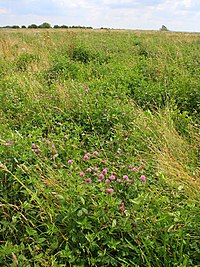
Photo from wikipedia
Chinese milk vetch (Astragalussinicus L.) is an environment-friendly green manure used for rice with low carbon/nitrogen (C/N) ratio and high moisture. To improve the added values of milk vetch, the… Click to show full abstract
Chinese milk vetch (Astragalussinicus L.) is an environment-friendly green manure used for rice with low carbon/nitrogen (C/N) ratio and high moisture. To improve the added values of milk vetch, the feasibility of co-composting of milk vetch with rice straw was evaluated. The probability of using the milk vetch-based compost as a peat substitute in seeding substrate of vegetable was further tested. The changes in physicochemical properties during co-composting of milk vetch and rice straw were evaluated, depending on three treatments: (1) milk vetch alone (MV), (2) co-composting of milk vetch and rice straws with 4:1 ration (w/w) (MV + S) and (3) MV + S with the addition of 3% (w/w) microbial inoculation (MV + S + M). The entire composting durations were 15 d, 24 d, and 24 d in MV, MV + S, MV + S + M composts. Compare to MV compost, both the MV + S, MV + S + M composts increased the temperature, pH, organic C, total nitrogen (N), total potassium (K) and the germination index (GI) (over 100) during the cooling/mature phase, and decreased total N loss, and generally, the improvements or reductions were greater in the MV + S + M compost than in the MV + S compost. Additionally, the MV + S + M compost was added at a peat substitute rates of 0%, 20%, 40%, 80% and 100% in a pot experiment to testify the utilization of milk vetch-based compost in substrates. The results showed that the substrate with 40% substitute rate increased the cabbage seeding growth, and that the electrical conductivity was the limiting factor of preventing the substitute rate increase. Another pot experiment demonstrated that the substrate with 40% peat substitute increased the cucumber growth as compared to the substrate without compost. In conclusion, the co-composting milk vetch with rice straw was feasible and quick, and microbial inoculation accelerated the composting process and improved the compost quality. The milk vetch-based composts were nutrient-rich and safe, and thus, can replace part of peat in vegetable seeding substrate. Keywords: Chinese milk vetch (Astragalussinicus L.), compost, peat, seeding substrate DOI: 10.25165/j.ijabe.20191201.4670 Citation: Chen Y F, Hu C, Liu D H, Li S L, Qiao Y. Co-composting of Chinese milk vetch with rice straw and using the compost as a peat substitute of seeding substrate of vegetables. Int J Agric & Biol Eng, 2019; 12(1): 214–219.
Journal Title: International Journal of Agricultural and Biological Engineering
Year Published: 2019
Link to full text (if available)
Share on Social Media: Sign Up to like & get
recommendations!